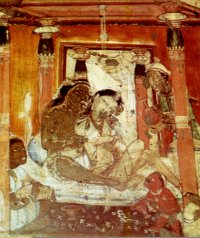PROSTITUTION

Prostitution is the selling of one's body for sexual purposes. Today, as in ancient India, people considered prostitution to be `the lowest type of livelihood' (antimajãvikà, Mil.122). Because it involves sexual behaviour and the exchange of money, prostitution pertains to the third Precept and also to the Buddha's teachings of Right Livelihood.
The issue of prostitution has to be looked at taking into account the prostitute and the customer. Roughly speaking, there are two types of prostitutes: (1) those forced into prostitution by poverty or social deprivation and (2) those who choose to do it because they feel it is a convenient and easy way to make money. This first type of prostitute is called a harlot (vesiyà) or a streetwalker (bandhakã) in the Buddhist scriptures while the second type is called a courtesan (gaõikà or nagarasobhinã). The intention of the first is probably just to survive and is, therefore, kammically far less negative than the second whose motive might be greed, laziness or lack of self-respect. The first is not willingly involved in wrong livelihood while the second clearly is.
Now what of the customer? Customers of the first type of prostitute are definitely breaking the first and third Precepts because they are sexually exploiting another person. The customers of the second type may not be breaking the third Precept, but they are hardly involving themselves in an activity likely to benefit themselves spiritually. Generally speaking, prostitution is a sordid and unedifying affair and sincere Buddhists would not involve themselves in it.
One of the Buddha's supporters was a woman named Ambapàlã who was a wealthy courtesan of Vesàli and who later gave up her trade to become a nun (D.II,95). In the scriptures we read of prostitutes charging 500 or even a 1000 coins a night for their company (Vin.I,268-9).